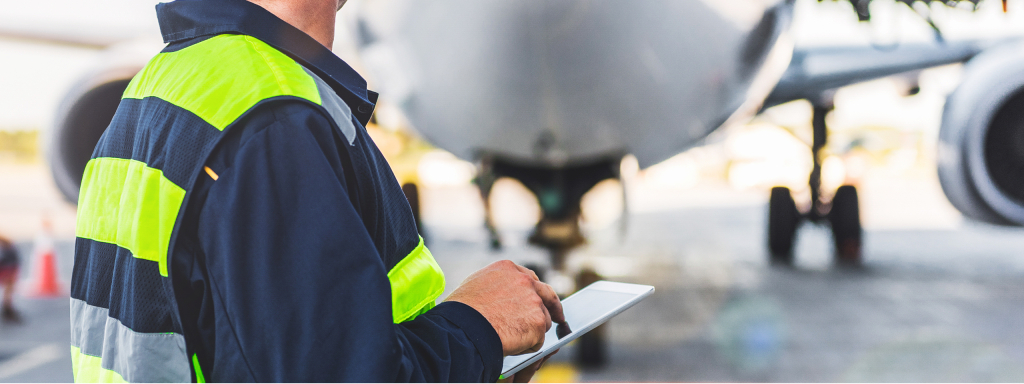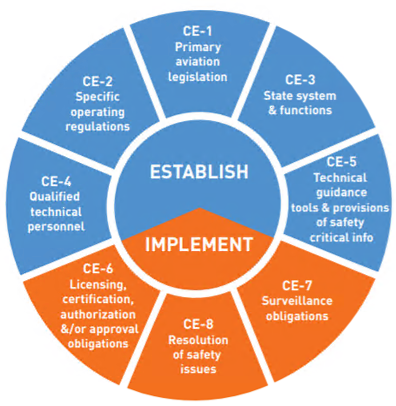Frequently Asked Questions about USOAP

What is the Universal Safety Oversight Audit Programme (USOAP)?
The USOAP is a programme through which ICAO monitors the fulfillment of the safety oversight obligations by it Member States. The results of USOAP activities allow ICAO to assess a State’s capability in providing safety oversight by assessing whether the State has effectively and consistently implemented the eight critical elements (CEs) of a safety oversight system, which enable the State to ensure the implementation of ICAO’s safety-related Standards and Recommended Practices (SARPs) and associated procedures and guidance material.

Have all countries been audited by ICAO?
As of January 1, 2025, ICAO has diligently carried out USOAP activities in 187 Member States. This is a remarkable achievement which represents 97% of all Member States responsible for the safety oversight of 99% of the international air traffic.
In addition to the traditional USOAP audits, ICAO has also conducted State Safety Programme Integrated Assessment (SSPIA) activities in 6 Member States: Australia, Brazil, Canada, Czechia, Italy, and Singapore. These assessments aim to enhance safety oversight capabilities and ensure consistent implementation of safety-related standards and practices.
Notably, the year 2023 marked a significant milestone - the 1000th USOAP activity took place in South Africa, reaffirming the commitment to aviation safety worldwide.
Looking ahead, 2025 promises further advancements. This year will witness the integration of traditional audit activities with the State Safety Programme (SSP), fostering a more comprehensive and cohesive approach to ensuring aviation safety across the globe.
What is Continuous Monitoring Approach (CMA)?
The USOAP CMA provides a mechanism for ICAO to collect and analyze safety information from Member States and other stakeholders to identify and prioritize appropriate oversight and monitoring activities to be carried out by ICAO. It is a strategy that uses a risk-based approach for measuring and monitoring the safety oversight capabilities and improving safety performance of States and global aviation on a continuous basis.
Under the CMA, cyclical audits are supplemented with an ongoing process of gathering safety information. This allow States and pertinent stakeholders in international civil aviation to base their decisions on the latest information available. In short, the CMA aims to provide continuous oversight of a State’s effective implementation of Standards.

What is a USOAP Audit?
A USOAP audit is an activity during which ICAO assesses the effective implementation of the critical elements (CEs) of a safety oversight system and conducts a systematic and objective review of a State’s safety oversight system to verify the status of a State’s compliance with the provisions of the Convention or national regulations and its implementation of ICAO Standards and Recommended Practices (SARPs), procedures and aviation safety best practices.
Audits are tailored to the level of complexity of aviation activities in the State to be audited. Timing, duration of audits, and size and composition of the audit teams are determined through a review of the information submitted by the State on the ICAO USOAP CMA Online Framework (OLF).
What do USOAP audits focus on?
USOAP audits focus on a States effective implementation of the eight critical elements (CE) of a safety oversight system. USOAP audits use a set of protocol questions (PQs) as a standardized tool to assess the level of effective implementation of a State’s safety oversight system. The PQs are organized in eight audit areas.
The eight CEs of a State’s safety oversight system are:

The eight audit areas of a Member State’s aviation system that the programme monitors are:
- Primary Aviation Legislation and Civil Aviation Regulations (LEG)
- Civil Aviation Organization (ORG)
- Personnel Licensing and Training (PEL)
- Aircraft Operations (OPS)
- Airworthiness of Aircraft (AIR)
- Aircraft Accident and Incident Investigation (AIG)
- Air Navigation Services (ANS)
- Aerodromes and Ground Aids (AGA)
What is an ICAO Coordinated Validation Mission (ICVM)?
ICAO will perform an ICVM to ascertain whether previously identified safety deficiencies have been resolved satisfactorily by assessing the status of corrective action plans or mitigating measures taken by Member States to address findings, including Significant Safety Concerns (SSCs). Simply put, an ICVM is not an audit, but rather a follow up on-site activity to validate progress made by Member States in resolving safety oversight deficiencies identified during a previous audit.
What other validation activities does USOAP employ?
Another form of validation activity like an ICVM is the off-site validation activity in which ICAO will ascertain whether previously identified safety deficiencies have been resolved satisfactory by assessing the status of implementation of corrective action plans or mitigating measures taken by Member States to address findings without traveling to the State. Off-site validation activities are limited to PQs that do not require on-site validation. Those are mostly PQs associated to the establishment and not the implementation safety oversight system.

What does the Effective Implementation (EI) measure?
EI is a measure of the State’s safety oversight capability, calculated for each critical element, each audit area or as an overall measure. The EI is expressed as a percentage. Any change in the status of a PQ for a State will lead to an update of the State’s EI.
Total number of satisfactory PQs
EI (%) = --------------------------------------------- × 100
Total number of applicable PQs
How are “Establishment” and “Implementation” associated with the CEs?
The CEs are categorized as “Establishment” CEs (CEs 1 to 5) and “Implementation” CEs (CEs 6 to 8). The establishment CEs represents what a State has to establish or develop such as required legislation and organizations (e.g., a civil aviation authority (CAA); an accident investigation authority), appoint a Director General (or equivalent position), hire qualified inspectorate staff, and develop programmes, processes, procedures and necessary guidance, forms and checklists. The implementation CEs represent how a State puts in use what they have established by issuing licences, approvals, authorizations and certificates. In addition, the State needs to perform surveillance of the issued licences, certificates, and authorisation holders as well as ensure safety deficiencies and issues identified are addressed and closed satisfactorily.
What is an MIR?
A mandatory information request (MIR) is a tool used by the USOAP to seek information or documentation from a State in regards to a State’s capability in performing safety oversight of its aviation system. A State is obligated to respond to a MIR based on the USOAP CMA Memorandum of Understanding signed by ICAO and State. If a State fails to respond to a MIR with complete, clear, and relevant information, or if a State fails to respond to a MIR within the specified timeframe, ICAO can generate a finding, or a Significant Safety Concern (SSC), if applicable.
What is a Significant Safety Concern (SSC)?
An SSC occurs when the State allows the holder of an authorization or approval to exercise the privileges attached to it, although the minimum requirements established by the State and by the Standards set forth in the Annexes to the Convention are not met, resulting in an immediate safety risk to international civil aviation.
During the course of an audit, an ICVM, or a MIR, ICAO may identify what is referred to as a ‘Significant Safety Concern’ (SSC) with respect to the ability of the audited State to properly oversee its airlines (air operators); airports; aircraft; and/or air navigation services provider under its jurisdiction. This does not necessarily indicate a particular safety deficiency but, rather, indicates that the State is not providing sufficient safety oversight to ensure the effective implementation of all applicable ICAO Standards. Full technical details of the ICAO findings are made available to the State’s Civil Aviation Authority to guide rectification, as well as to all ICAO Member States to facilitate any actions that they may consider necessary to ensure safety. The audited State also undertakes to regularly report to ICAO progress on the correction of the safety concern.
If ICAO identifies a Significant Safety Concern (SSC) during the course of an audit, does it mean that it is unsafe to fly to that country? Or to fly with an airline from that State?
As indicated above, the identification of a Significant Safety Concern does not necessarily indicate a particular safety deficiency but, rather, indicates that the State is not providing sufficient oversight to ensure the effective implementation of all applicable ICAO Standards. It is important to emphasize that ICAO does not directly audit the aviation industry or aviation service providers. ICAO audits focus on the safety oversight capability of the designated governmental authority responsible for civil aviation. For more specific information on the safety of the various components of the State’s aviation system (i.e., the airlines, airports, aircraft or air navigation service providers), the public should refer to applicable travel advisories as may be issued by national or regional authorities.

What training is available related to the USOAP CMA?
Currently, there are several USOAP training options available. These include:
USOAP CBT Training Phases I and II
This course contains information, instructions, and guidance on the various aspects of the USOAP ranging from general auditing techniques to specific State safety oversight obligations in each technical area.
USOAP Auditor Preparation
This instructor-led course provides USOAP auditor candidates with the competencies required to perform audits with minimal supervision and coaching in preparation for the OJT/checkout mission.
USOAP CMA Workshop
This in-person workshop provides participants with information and practical experience with the tools and functionalities that support the USOAP CMA.
OLF Work User Management Tutorial
This tutorial provides National Continuous Monitoring Coordinators (NCMCs) with information on how to provide relevant access levels to users in their respective States.
OLF Tutorial
This tutorial teaches authorized users about the functionality of the OLF and how it supports the USOAP CMA.
Managing SAAQ Module
This module provides information on the tools and functionalities to complete and update State Aviation Activity Questionnaire (SAAQ) information on the OLF.
Additional information on USOAP training can be found under the Training page of the USOAP CMA website or on the USOAP CMA Online Framework (restricted).
What is a State Safety Programme Implementation Assessment (SSPIA)?
A SSPIA is a USOAP CMA performance-based activity in which ICAO assesses the level of maturity of a State’s safety programme (SSP) by conducting a systematic and objective review of the State’s implementation and maintenance of its SSP.
What does a SSPIA focus on?
SSPIAs focus on a State’s maturity level, which is an indication of the maturity achieved by the State in its implementation and maintenance for each SSP-related protocol question (PQ) that is generated following a SSPIA. SSP-related PQs does not affect a State’s EI.
The eight assessment areas of a State’s SSP that the programme assesses are:
- SSP General Aspects (GEN)
- Safety Data Analysis (SDA)
- Personnel Licensing and Training (PEL)
- Aircraft Operations (OPS)
- Airworthiness of Aircraft (AIR)
- Aircraft Accident and Incident Investigation (AIG)
- Air Navigation Services (ANS)
- Aerodromes and Ground Aids (AGA)
How do I gain access to the CMA Online Framework (OLF)?
You will need to contact your State’s National Continuous Monitoring Coordinator (NCMC) for access to the OLF, which is located at www.icao.int/usoap.

How do I contact the USOAP CMA?
The USOAP can be contacted by e-mail at usoap [at] icao.int (usoap[at]icao[dot]int).
Note: It is strongly encouraged that you coordinate with your State’s NCMC before contacting the USOAP for information.